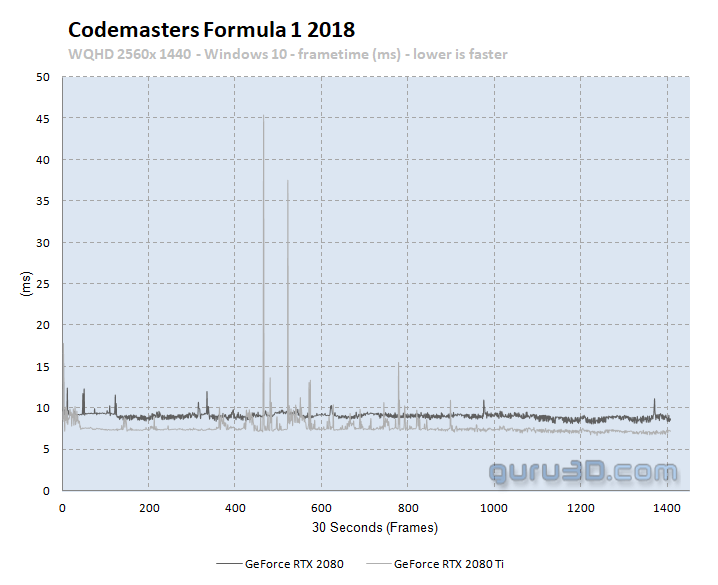Frametime Analysis: Shadow of Mordor and Codemasters F1 2018
Frametime and latency performance
The charts below will show you graphics anomalies like stutters and glitches in a plotted chart. Frame time and pacing measurements.
| Frame time in milliseconds |
FPS |
| 8.3 | 120 |
| 15 | 66 |
| 20 | 50 |
| 25 | 40 |
| 30 | 33 |
| 50 | 20 |
| 70 | 14 |
- FPS mostly measures performance, the number of frames rendered per passing second.
- Frametime AKA Frame Experience recordings mostly measures and expose anomalies - here we look at how long it takes to render one frame. Measure that chronologically and you can see anomalies like peaks and dips in a plotted chart, indicating something could be off.
We have a detailed article (read here) on the methodology behind it all. Basically the time it takes to render one frame can be monitored and tagged with a number, this is latency. One frame can take say 17 ms. Higher latency can indicate a slow framerate, and weird latency spikes indicate a stutter, jitter, twitches; basically, anomalies that are visible on your monitor. What these measurements show are anomalies like small glitches and stutters that you can sometimes (and please do read that well, sometimes) see on screen. Below I'd like to run through a couple of titles with you. Bear in mind that Average FPS often matters more than frametime measurements.
As you might have observed, we're experimenting a bit with our charts to give it a little more clarity. At the left side, you can see the frame time in milliseconds (ms). At the x-axis, 30 seconds of the game spread out over roughly 1400~1500 frames. Please understand that a lower frame time is a higher FPS (!), so for these charts, lower = better. Huge spikes would be stutters, thicks lines would be bad frame pacing, and the graduate streamlining is framerate variation.
Above frame time latency/pacing measurements (frame-times). Above, the card at 2560x1440. On this 30-second run, we include both the GeForce RTX 2080 and 2080 Ti. Both the graphics card manage well when you look at pacing. There are a few stutters visible and also measured, this, however, is the game engine and is something you would see with any card. For frame-times, lower is better. Overall we cannot complain here.
Codemasters released the 2018 version of Formula 1 - this is the scripted time-demo based on the internal benchmark with the Australia circuit where we do a lap. We have two stutters for the Ti, again, this is the game engine, nothing to worry about. You can also see a bit more variance, but here again, that's the game as the car tries to overtake or bump into a very crowded field of opponents. The RTX 2080 if you would zoom in on the frame times exhibits slightly more frame pacing, it's incredible marginal though. Nothing here worries me.



